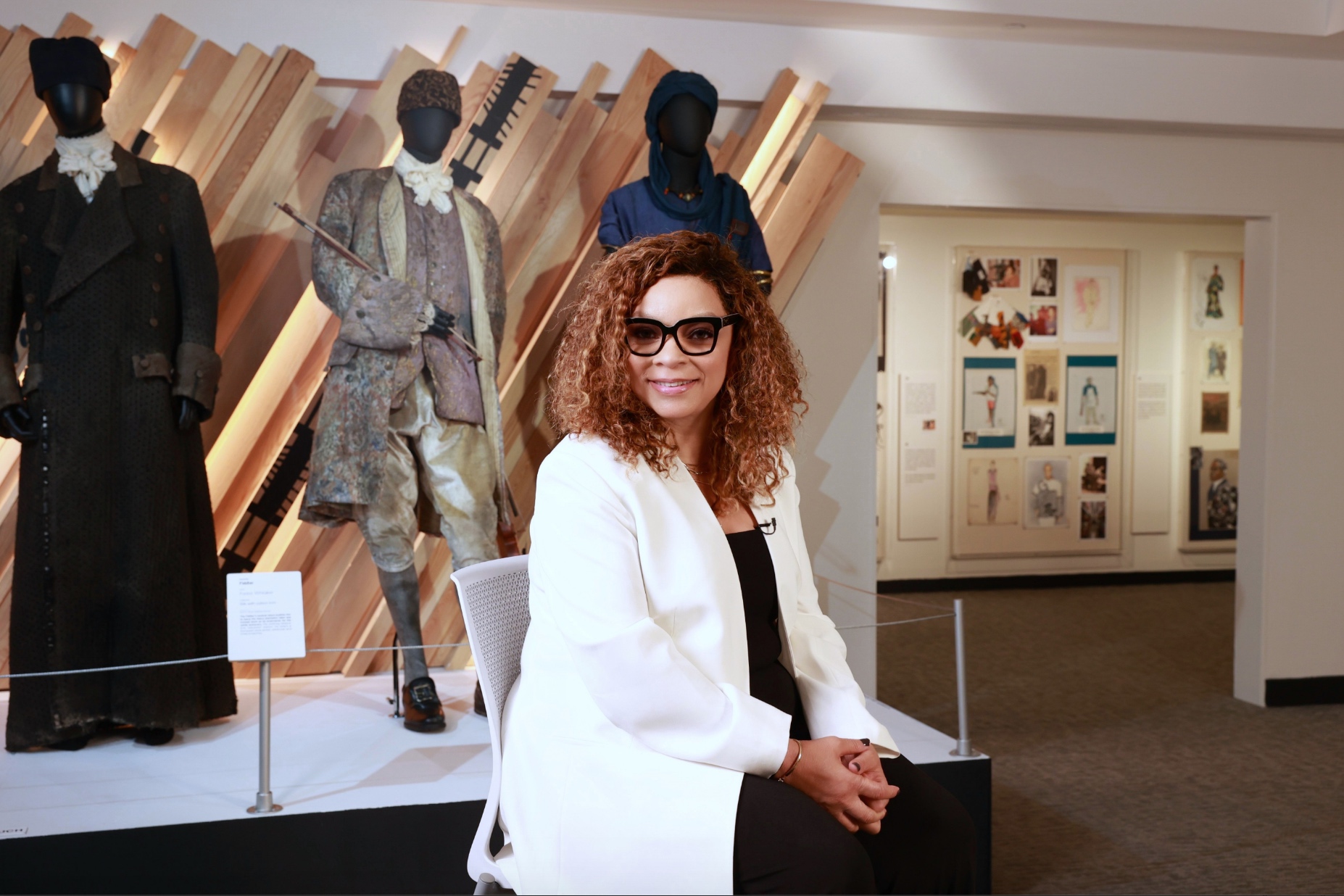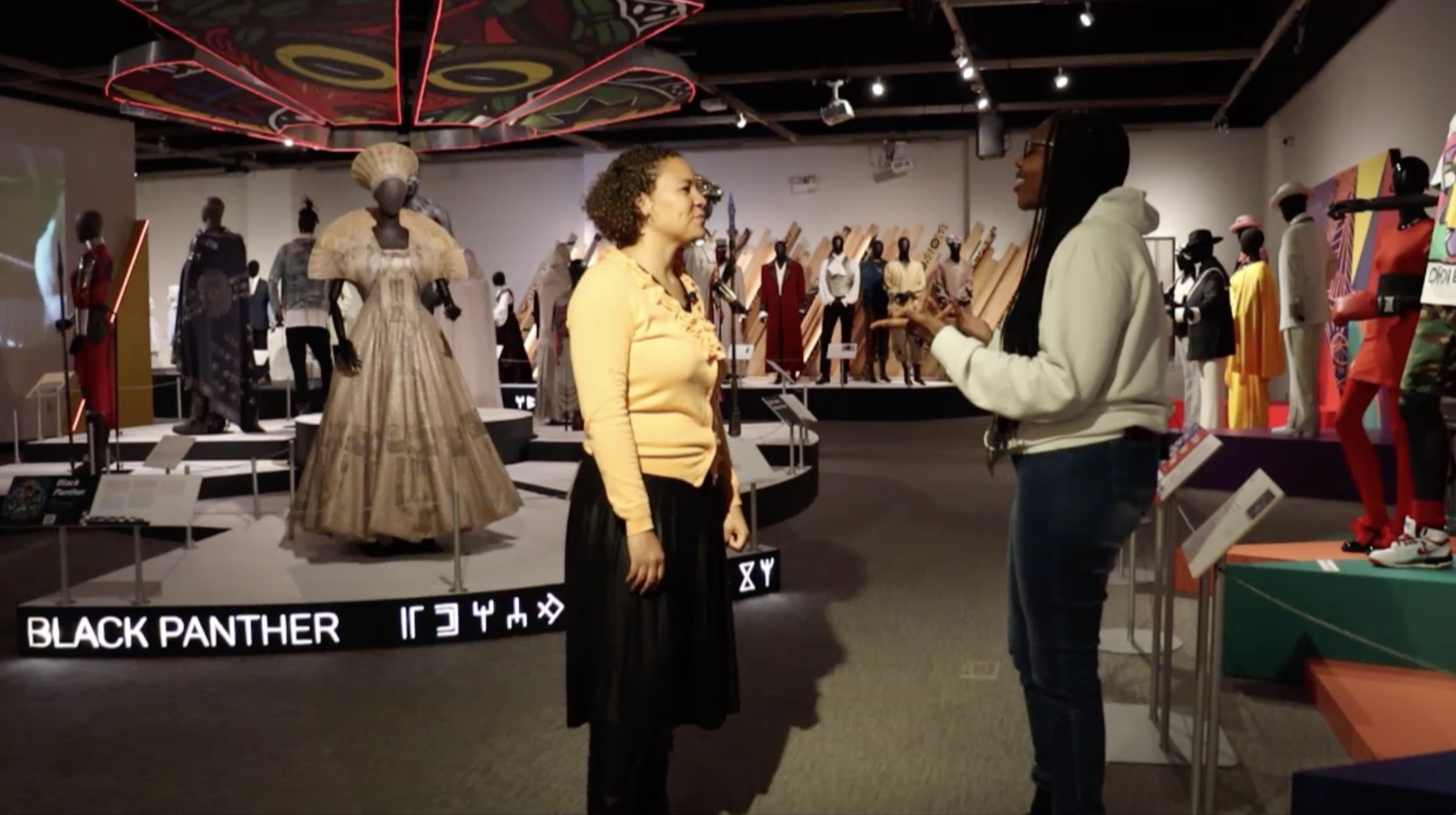Wright Museum Hosts Exhibit of Oscar-winning Costume Designer Ruth E. Carter

Two-time Oscar winner Ruth E. Carter at the Charles H. Wright Museum of African American History in Detroit. Photo by Andrea Stinson Oliver - Detroit Metro Times.
Over sixty designs by Ruth E. Carter, the first black woman to win an Academy Award for Costume Design, are on exhibit at the Charles H. Wright Museum of African American History. Exhibition manager, Jennifer Evans, shared the history, legacy and impact of Carter’s work for their “Afrofuturism in Costume Design” exhibition.
Carter’s childhood sewing machine is on display, evidence of humble beginnings and a lifelong dedication to the craft. Most known for her costume work for Marvel’s Black Panther films, she began her journey as an intern at the Sante Fe Opera after graduating from Hampton University. Moving to Los Angeles in the late 1980’s, she scored a job with filmmaker Spike Lee for his movie “School Dayz.” Afterwards, Lee and Carter continued their collaborative relationship, which laid a solid foundation for the remainder of her career.
“Do The Right Thing was released in 1989 and directed by Spike Lee, and that was one of Cater’s earliest relationships with him. [After that] she continued to create costumes for his other films displayed here,” Evans explains.
Costumes worn by Bill Nunn as "Radio Raheem" (left) and Spike Lee as "Mookie" (right) from Spike Lee's "Do the Right Thing." Photo by Ashley Davis.
The designer went on to work with other big names in Hollywood like Steven Spielberg, where her work for his 1997 film Amistad led to her second Academy Award nomination. Carter would continue to garner a host of nominations over the years, finally winning awards for Eddie Murphy’s Dolemite Is My Name (2019) and Coming 2 America (2021), as well as Marvel’s Black Panther (2018) and Wakanda Forever (2022). Carter has also received multiple lifetime achievement awards from the likes of the Costume Designers Guild and the American Black Film Festival.
Upon entering the brightly colored exhibition space, you will be surrounded by almost four decades of Carter’s experience in movies and television. Evans said, “We have [designs from] Amistad in the back, which was rooted in the real-life event of a revolt of the Spanish slave ship. Malcom X is here, which is a biopic of his life. And then we have Selma, which revolves around the Selma march. All the research she does in preparation for creating the costumes definitely seems to set her apart.”

Costumes worn by Spike Lee as "Shorty" (left) and Denzel Washington as Malcolm "Detroit Red" Little from Spike Lee's film, "Malcolm X." Photo by Ashley Davis.
The Charles Wright Museum has the largest permanent collection of African American culture in the world, making it the perfect place for visitors to learn about history through Carter’s collection.
Evans observes, “This is a great exhibition because it tells history in a unique way. Many of the films are based on actual events, so people can rediscover an event or a moment in time that they don’t know much about, or may have forgotten about.”
She continues to discuss what else we can learn from observing the garments. “In the center here is Black Panther, and within the costume alone, you can see the different African ethnicities and traditions without needing to know anything about the film itself. Or so many of these costumes are historic, but some of the things we continue to wear. Some styles keep coming back, inspired by the previous design, so [fashion] is another really cool way to rediscover that history.”
Afrofuturism is a source of inspiration for Carter’s archive on display. This concept is the futuristic and science fiction inspired reimagining of Black Americans, Africans and other Afro-indigenous groups without “the limiting construct of slavery and colonialism” in the designers words. Using this principle to “break free” from the limits of design, Carter incorporated the use of 3D printing to create textiles and accessories.
Evans talks about the significance of this art form as it relates to the exhibit. “Afrofuturism is very important to the exhibit, which is an interesting concept for visitors to learn through costume. We describe it as a creative aesthetic movement that shows up in many art forms like film and literature. Carter captures that concept through her research, where she’s kind of pulling the past into the future in a really interesting way. You see this kind of marriage between African [culture] and futurism by taking an old tradition or aesthetic, but [advancing] it to the present and beyond.”
According to The Hollywood Reporter, only five Black, indigenous, or people of color (BIPOC) have won an Academy Award in costume design categories since 1949. This includes Carter, whose historic win made her the first black woman to win an Academy Award for costume design, and first to win in multiple categories.

Costume for Letitia Wright from "Black Panther: Wakanda Forever." Photo by Ashley Davis.
Evans feels this success has increased the visibility of the art form and translated to increased interest in costume design.
Evans said, “Her win certainly drew attention to fashion design in a different way. Since she won two awards consecutively, there was something unique and refreshing about it all. Even the ways in which the media covered her story was very exciting. I think [clothing design] is one of the parts of filmmaking that is often invisible.”
Through programs like the Boston Arts Academy Foundation, Ruth Carter continues to give back to the community by advising and collaborating with promising young artists.
Evans adds, “She really is working to mentor up-and-coming fashion designers and trying to help young people navigate the world of the film industry. Carter’s success helped people understand that costume design is a viable career in which you can thrive, and it’s an avenue in which you can tell a story. There are lots of ways to showcase yourself now as a seamstress, tailor or designer. How do the costumes tell the story?”
"Ruth E. Carter: Afrofuturism in Clothing Design" will be on display at the Charles Wright Museum until March 31, 2024. Tickets are available at thewright.org.

